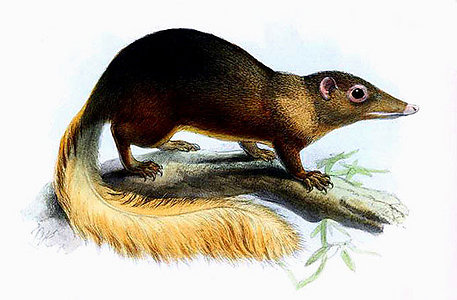Scandentia
Tree shrews



This tree diagram shows the relationships between several groups of organisms.
The root of the current tree connects the organisms featured in this tree to their containing group and the rest of the Tree of Life. The basal branching point in the tree represents the ancestor of the other groups in the tree. This ancestor diversified over time into several descendent subgroups, which are represented as internal nodes and terminal taxa to the right.

You can click on the root to travel down the Tree of Life all the way to the root of all Life, and you can click on the names of descendent subgroups to travel up the Tree of Life all the way to individual species.
For more information on ToL tree formatting, please see Interpreting the Tree or Classification. To learn more about phylogenetic trees, please visit our Phylogenetic Biology pages.
close boxReferences
Bedford, J. M. 1997. Unusual nature and possible evolutionary implications of the male vesicular gland secretion in the tree shrew, Tupaia glis. Anatomical Record 247:199-205.
Bloch, J. I. and D. M. Boyer. 2002. Grasping primate origins. Science 298:1606?1610.
Corbert, G. B. and J. E. Hill. 1992. The Mammals of the Indomalayan Region: A Systematic Review. Oxford University Press, Oxford.
Emmons, L. H., 2000. Tupai: A Field Study of Bornean Treeshrews. University of California Press, Berkeley.
Han, K. H., F. H. Sheldon, and R. B. Stuebing. 2000. Interspecific relationships and biogeography of some Bornean tree shrews (Tupaiidae : Tupaia), based on DNA hybridization and morphometric comparisons. Biological Journal of the Linnean Society 70:1-14.
Luckett, W. P. (ed.) 1980. Comparative Biology and Evolutionary Relationships of Tree Shrews. Plenum Press, New York.
Martin, R. D. 2001. Tree Shrews. Pages 426?431 in: The New Encyclopedia of Mammals. D. Macdonald, ed. Oxford University Press, Oxford.
McKenna, M. C. and S. K. Bell. 1997. Classification of Mammals Above the Species Level. Columbia University Press, New York.
Nowak, R.M. 1999. Order Scandentia. Pages 244-249 in: Walker's Mammals of the World. Sixth Edition. Volume I. Johns Hopkins University Press, Baltimore.
Olson, L. E., E. J. Sargis, and R. D. Martin. 2004. Phylogenetic relationships among treeshrews (Scandentia): a review and critique of the morphological evidence. Journal of Mammalian Evolution 11:49?71.
Olson, L. E., E. J. Sargis, and R. D. Martin. 2005. Intraordinal phylogenetics of treeshrews (Mammalia: Scandentia) based on evidence from the mitochondrial 12S rRNA gene. Molecular Phylogenetics and Evolution 35:656-673.
Sargis, E. J., 1999. Tree Shrews. Pages 1286?1287 in: Encyclopedia of Paleontology. R. Singer, ed. Fitzroy Dearborn, Chicago.
Sargis, E. J. 2002. The postcranial morphology of Ptilocercus lowii (Scandentia, Tupaiidae): an analysis of primatomorphan and volitantian characters. Journal of Mammalian Evolution 9:137?160.
Sargis, E. J. 2002. Functional morphology of the forelimb of tupaiids (Mammalia, Scandentia) and its phylogenetic implications. Journal of Morphology 253:10?42.
Schlitter, D. A. 1993. Order Macroscelidea. Pages 829-830 in Mammal Species of the World. Second Edition. D. E. Wilson and D. M. Reeder, eds. Smithsonian Institution Press, Washington.
Schmitz, J., M. Ohme, and H. Zischler.2000. The complete mitochondrial genome of Tupaia belangeri and the phylogenetic affiliation of Scandentia to other eutherian orders. Molecular Biology and Evolution 17:1334?1343.
Wible, J. R. and U. Zeller. 1994. Cranial circulation of the pen-tailed tree shrew Ptilocercus lowii and relationships of Scandentia. Journal of Mammalian Evolution 2:209-230.
Yates, T. L. 1984. Insectivores, elephant shrews, tree shrews, and dermopterans. Pages 117-144 in Orders and Families of Recent Mammals of the World. (S. Anderson and J. K. Jones, Jr., eds.) John Wiley and Sons.
Information on the Internet
- Order Scandentia. Animal Diversity Web. University of Michigan Museum of Zoology.
- What Is A Tree Shrew? National Wildlife Federation.
- Eurasian Insectivores and Tree Shrews: Status Survey and Conservation Action Plan. Insectivore, Tree Shrew & Elephant Shrew Specialist Group. IUCN - The World Conservation Union. Species Survival Commission.
- Link Olson: Research Interests.
About This Page
Page copyright © 2005
 Page: Tree of Life
Scandentia. Tree shrews.
The TEXT of this page is licensed under the
Creative Commons Attribution-NonCommercial License - Version 3.0. Note that images and other media
featured on this page are each governed by their own license, and they may or may not be available
for reuse. Click on an image or a media link to access the media data window, which provides the
relevant licensing information. For the general terms and conditions of ToL material reuse and
redistribution, please see the Tree of Life Copyright
Policies.
Page: Tree of Life
Scandentia. Tree shrews.
The TEXT of this page is licensed under the
Creative Commons Attribution-NonCommercial License - Version 3.0. Note that images and other media
featured on this page are each governed by their own license, and they may or may not be available
for reuse. Click on an image or a media link to access the media data window, which provides the
relevant licensing information. For the general terms and conditions of ToL material reuse and
redistribution, please see the Tree of Life Copyright
Policies.
Citing this page:
Tree of Life Web Project. 2005. Scandentia. Tree shrews. Version 01 January 2005 (temporary). http://tolweb.org/Scandentia/15964/2005.01.01 in The Tree of Life Web Project, http://tolweb.org/








 Go to quick links
Go to quick search
Go to navigation for this section of the ToL site
Go to detailed links for the ToL site
Go to quick links
Go to quick search
Go to navigation for this section of the ToL site
Go to detailed links for the ToL site